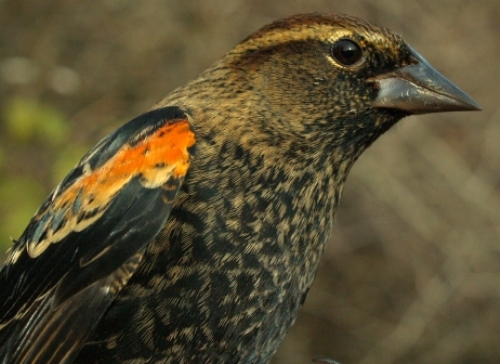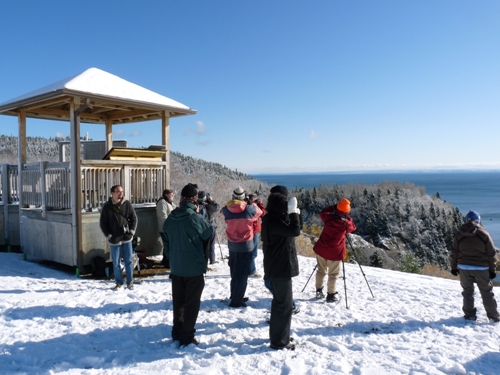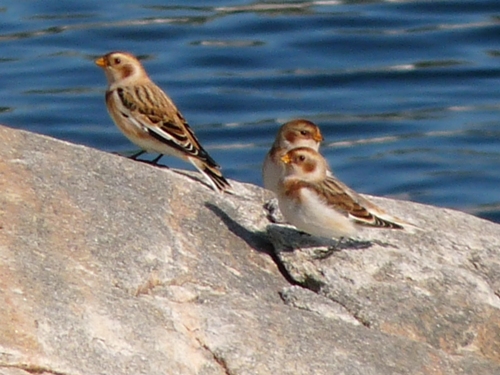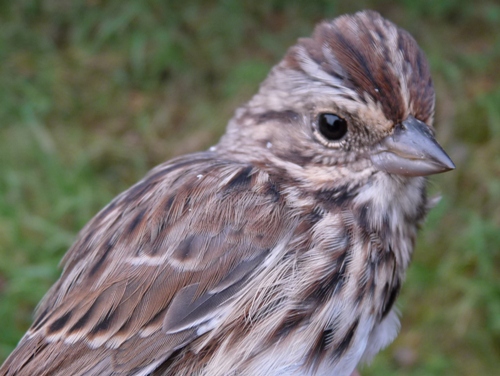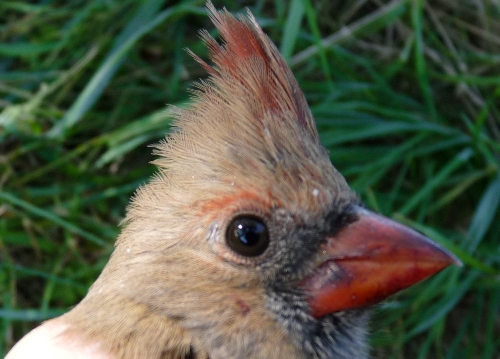|
McGILL BIRD OBSERVATORY |
||||||||||||||||||||||||||||||||||||||||||||||||||||||||||||||||||||||||
Welcome
to the McGill Bird Observatory weekly report.
Click here for a complete listing of our archives.
Banders-in-charge: Simon Duval, Marcel Gahbauer, Gay Gruner Notes: This is traditionally the time of year when things start to get quieter at MBO, but this week proved to be an exception to that pattern. Not only did our numbers increase over last week, but we had the highest number of birds (and diversity of species) ever banded in week 12! A return to more seasonal temperatures no doubt played a role in this week's migration. On Friday, we banded our 3000th bird of this fall, a milestone we've reached in four of our five fall migration monitoring programs. We added another three species to our list of birds seen this fall - Great Black-backed Gull, Killdeer, and Field Sparrow. None of the species we banded this week were new for the season, but we did have our first Blue Jay and American Robin returns of the fall. While Simon and Gay were busy keeping things running smoothly at MBO, Marcel and Marie-Anne headed up to Tadoussac this week for a four-day meeting of the Canadian Migration Monitoring Network. This group, comprised of members from 28 bird observatories across Canada as well as representatives from Bird Studies Canada and Environment Canada, meets every second fall to discuss issues related to migration monitoring, including ways in which members can collaborate to improve scientific accuracy and output. As always it was a very positive, interesting, and productive experience, and over the winter we will consider tweaking some elements of our operations at MBO to incorporate ideas discussed at this meeting.
Last week we commented on the phenomenal week of owl banding we had. This week numbers were much more modest, with only 7 more individuals banded. However, in addition to them, we had two foreign recaptures, i.e. birds that had previously been caught and banded elsewhere. One was a female banded as a second-year bird at Whitefish Point in northern Michigan in July 2008, while the other one was also a female, banded on migration in Shenandoah State Park, Virginia, in November 2008. In an earlier year we also recaptured a saw-whet banded at Prince Edward Point, Ontario ... so we figure it is about time that someone else finds and reports one of the owls we have banded at MBO! For a second straight week, Slate-coloured Junco and American Robin remained distinctly on top as the most frequently banded species, but with the juncos taking the lead this week. White-throated Sparrows continue to move through in decent numbers, and while the chickadee migration isn't overwhelming this year, the fact that we banded 31 this week certainly indicates that they are on their way through as well. However, the most surprising entry on this week's list of species banded is Red-winged Blackbird. While we band plenty in spring, they usually stay high in fall and we've never before banded more than 7 in an entire fall season. This year we hadn't caught a single one heading into this week, so to band 30 this week alone was quite remarkable. Needless to say, this is one species for which fall banding counts aren't terribly meaningful at MBO; rather we need to consider the number of individuals observed daily as a better indicator of their abundance. The bottom half of this week's list was rounded out by the omni-present Song Sparrow, new arrivals in the form of Fox Sparrow and American Tree Sparrow, and some late-lingering kinglets (both Ruby-crowned and Golden-crowned).
We usually see large Red-winged Blackbird flocks at this time of fall, but this year they seem to be larger than ever. On average they slightly outnumbered American Robins this week, which in turn were almost twice as numerous as Canada Geese. American Crows remain very numberous, while both juncos and chickadees were migrating through in large enough numbers daily to make it to the middle of this week's list. Starlings and Common Grackles flew overhead in large flocks at times, while there are still plenty of White-throated Sparrows singing away around dawn most mornings, and the Blue Jays appear to be enjoying the corn in the neighbouring field. White-crowned Sparrow and Ruby-crowned Kinglet dropped off from last week's list, and we don't expect to see them in any numbers again until early next May. We have just two weeks left in this year's Fall Migration Monitoring Program, and with the cold weather of the past few days it feels in some ways like the end of the season should be coming even sooner! But we take heart in the warming trend shown in the long-range weather forecast, and hope that we'll have a good finish to the season ... no doubt with many more robins and juncos, but perhaps also a few surprises still. After all, some very northern breeders have yet to put in an appearance at MBO this fall, and with the early cold snap there may be increased opportunities to spot some of them, whether in the nets (e.g. shrikes or finches) or overhead (e.g. raptors and waterfowl).
|

